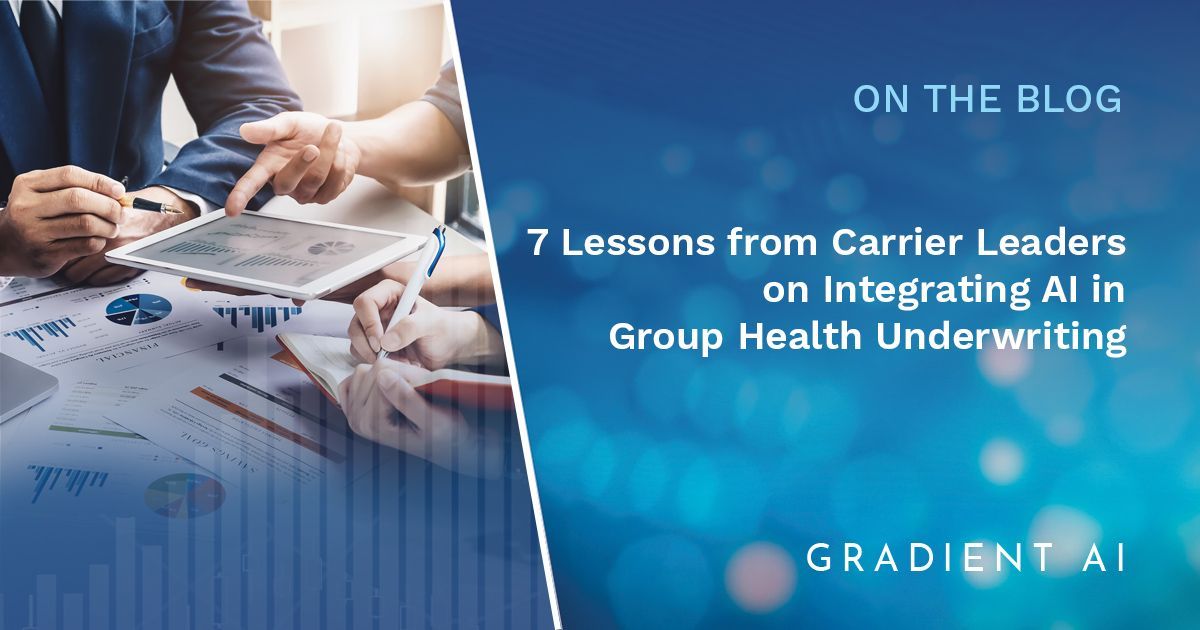7 Lessons from Carrier Leaders on Integrating AI in Group Health Underwriting
An increasing number of group health carriers are using AI to improve underwriting. But getting started isn’t always easy. At a recent roundtable hosted by Gradient AI, underwriting leaders from several well-known carriers talked openly about what worked for them, what didn’t, and what they wish they had known earlier. Their advice is practical, straightforward, and worth hearing.
Here are seven lessons from insurance leaders to keep in mind if you're thinking about bringing AI into your underwriting operations.
1. Carriers are making AI a key part of their underwriting processes now.
Carriers aren’t just experimenting with AI; they’re adopting it out of necessity. As Matthew Agdish, AVP Underwriting, Blue Choice Health Plan, reflected: “When I came into this leadership role, we didn’t have any predictive analytics. That put us behind. Now with Gradient AI’s predictive analytics solution, we’re actually ahead of the curve.”
Takeaway: Embrace AI to catch up - or stay ahead - in the competitive landscape of Group Health underwriting.
2. AI unearths real risk patterns and finds the right business
Platforms powered by AI and machine learning algorithms help uncover underwriting opportunities beyond basic demographics. Nancy Schiel, VP of Underwriting, Commercial Markets Division, Medica shared: “We had a tight corridor of average groups. AI helped us finally identify good‑risk groups more accurately, which was the missing piece.”
Takeaway: Be more discerning - and strategic - in risk segmentation to better manage your portfolio.
3. Watch for integration pitfalls: calibration, blind trust, and delays
There are several significant challenges associated with adopting AI, including over-relying on risk scores without understanding their drivers, misalignment with your cost structures, and slow rollout timelines. As Josh Phelps, Solutions Consulting, Group Health, Gradient AI, warned: “Slow adoption has been a major misstep… Some have waited too long, and now they’re trying to catch up.”
Takeaway: Start early, align outputs with your data and pricing levers, and blend AI with actuarial judgment.
4. AI helps underwriters rather than replacing them
Contrary to fears of job displacement, AI empowers underwriters. Nancy Schiel of Medica noted: “There was initial concern about job security. But our team quickly saw how AI improved their effectiveness.”
Takeaway: When properly implemented, AI enhances consistency, builds confidence, and frees teams for strategic work.
5. Build or buy? Vendor data scale tips the balance
While some carriers consider building in-house AI, the sheer scale of vendor data sets tips the scales. Josh Phelps of Gradient AI emphasized: “Focus on results‑driven outcomes. Trust and verify.”
Takeaway: Leverage high-quality vendor solutions for richer data, faster impact and validation.
6. Understand AI vs. machine learning for smarter deployment
Develop internal AI fluency. Knowing the difference between AI (decision‑making systems) and ML (systems that learn and improve) makes a difference. Josh Phelps of Gradient AI said: “Without clarity, you may get static rules that never improve, or opaque ML models that are hard to interpret.”
Takeaway: Clearly define your strategy up front, then pick the right tool to meet it. Here’s more information on the difference between AI and machine learning.
7. Adopt AI with care: use change agents to secure buy-in
A solid change‑management strategy is key. Change management strategies will help you to set up a successful plan to assess readiness, align stakeholders, and appoint change agents to guide the transition.
Takeaway: Strong governance and intentional communication underpin successful AI adoption. Read Gradient AI’s guide to 6 Change Management Steps for Successful Adoption of AI in Insurance for how to execute a well-planned change management strategy.
Final Thoughts
These seven carrier‑sourced insights illustrate a path to successful AI integration: treat it as essential, manage it smartly, and lead people through the change.
Interested in bringing this to life at your organization? Reach out to Gradient AI for a strategic, results‑driven pilot.
Stay on top of AI trends by subscribing to Advanced Insights, the newsletter for strategies, ideas, and insights on AI in insurance. Delivered monthly to your inbox. Subscribe Now →


